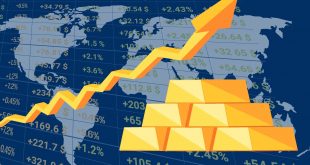Geopolitics continued to impact the economic outlook throughout the previous week. Christine Lagarde emphasized the punitive measures were designed to target the regime, not the Russian people, while new “fiscal remedies are still needed” to stabilize Europe’s economy.
Russia’s invasion of Ukraine on 24 February has fundamentally brought about deep economic consequences. Four weeks into the war, Russia continues its bombardment of cities. Economic damage to both countries will be substantial. Through sanctions, trade policies, and private investment decisions, Russia will be isolated for years to come. Ukraine must endure the massive displacement of people and destruction of property.
Energy
On Monday, WTI crude bulls were back in control of global oil markets, following catalysts from last week which sent front-month WTI future as nearly $5.0 higher on the session to test the $110 per barrel area. A couple of days later, WTI touched fresh weekly highs around $114.00. On Thursday, WTI kept swinging between the $112s and upper $116s as traders weighed various themes, including supply disruption.
The United States said it would work with international partners to provide at least an additional 15 billion cubic meters of liquefied natural gas to EU member states this year. On the other hand, Russia said on Thursday that NATO is reaping terrible results from the decision to pump Ukraine with weapons, Reuters reported citing RIA news agency. Russian energy giant Gazprom said on Tuesday it was still supplying gas to Europe via Ukraine in line with the demands of European consumers.
On Friday, a Saudi Aramco oil facility located in Jeddah, Saudi Arabia, was hit by a missile launched by Yemen’s rebel Houthi militia on Friday, reports on social media suggested.
The bulls were firmly back in control of global oil markets following a series of bullish catalysts over the weekend which has sent the front-month WTI future as nearly $5.0 higher on the session to test the $110 per barrel area.
Gold
The Gold Index (XAU/USD) prices have seen indecisive, two-way price action in recent trade, swinging between the mid-$1940s and $1960s. A sharp rally in US yields to fresh multi-year highs to reflect an upping of hawkish Fed bets as market participants reacted to a chorus of major US banks issues hawkish new Fed policy calls helped push XAU/USD back from weekly highs in the $1960s.
But geopolitical uncertainty, this time regarding the security of Saudi Arabia’s oil infrastructure after a site in Jeddah was hit by a Houthi missile, is helping keep pricing underpinned above support in the form of recent highs in the $1940s area.
Equities
European shares opened slightly higher on Wednesday, extending gains for the sixth consecutive session, despite continuing concerns about the economic fallout from the Ukraine crisis.
Shares of energy and basic materials companies were among the biggest gainers, as fears of supply shortages due to the war between Russia and Ukraine pushed up metal and oil prices.
After a strong delivery from Wall Street and Asian stock markets, the European Stoxx 600 index boosted its recovery by 0.1 percent. The index closed yesterday with marginal gains.
Ukrainian President Volodymyr Zelensky said talks between Ukraine and Russia were facing great difficulties but were moving forward as the West planned to announce more sanctions on Moscow amid a deepening humanitarian crisis.
Currencies
On Monday, The USD started the American session on the back foot but gradually strengthened following hawkish comments by US Fed Chair Jerome Powell. Speaking about the economic outlook at the National Association for Business Economics Annual Economic Policy Conference, Powell said that if they need to raise fed funds rate by more than 25 bps at a meeting or meetings, they will do so, adding that in times when circumstances change swiftly, Fed predictions might become out of date soon.
On Thursday, The US dollar climbed against its most major counterparts in the New York session on Friday, as US treasury yields rose amid growing expectations that the Federal Reserve will tighten monetary policy aggressively to curb high inflation.
The benchmark yield on the 10-year treasury note spiked up to 2.462 percent. Yields move inversely to bond prices. Chicago Fed President Charles Evans said on Thursday that he supported a quarter-point rate hike at the remaining meetings through next March, but is “open-minded” about a possible 50-basis-point move.
Cryptocurrencies
A senior Russian government official announced that Russia will start accepting payments in bitcoin for its oil and gas exports. Bitcoin rose to a three-week high as cryptocurrencies moved with major stock market indices. Bitcoin rose to $42,673, up 4.1% within only 24 hours. The price of the largest cryptocurrency by market value touched $43,337 earlier Tuesday, the highest point since 3 March.
Global Inflation, Tightening Monetary Policy
US jobless claims set a more than 50-year low last week as the red-hot labour market shows few signs of cooling in the near-term. The Labour Department released its latest weekly jobless claims report Thursday.
Jobless claims fell by 28,000. Initial jobless claims, week ended March 19: 187,000 versus. 210,000 expected and a revised 215,000 during prior week. Continuing claims, week ended 12 March 1.350 million versus 1.400 million expected and a revised 1.417 million during prior week.
The US Fed faces a predicament, struggling fresh data that was not positive. February’s consumer prices were up 7.9% from a year earlier. Fed is combating inflation while not sinking the US economy. Inflation will likely worsen; making the biggest Fed’s headache because of Eastern Europe’s war. This is basically why major central banks, led by the US Fed, were starting to tighten monetary policy. Former US Treasury secretary Larry Summers explained it, saying “the Fed might have to boost interest rate to 5%”. (PCE-deflator); Fed’s favorite measure of inflation, is now for 4.3% inflation in 2022 (compared to a December forecast of 2.6%). The BoE and Taiwan’s central bank hiked interest rates. The ECB signaled ending asset purchases. The simultaneous actions of several central banks are a response to the recent surge in global inflation.
The Eurozone economy is more vulnerable to the impact of the war in Ukraine than that of the United States or the UK. Christine Lagarde said this week that interest rate normalization will not commence until at least several months after the ECB ends its asset-purchasing program.
China’s economy and the war in Ukraine
China kept the key interest rate for lending to businesses and individuals unchanged on Monday, according to what traders and analysts expected. China’s government issued relatively favorable economic data last week, taking into account the timing of the Lunar New Year holiday. The data shows that, in January and February, retail sales increased 6.7% from a year earlier, the best performances since July 2021.
Industrial production rebounded to grow 7.5% from a year earlier, the best performance since June 2021. And fixed asset investment was up 12.2% from a year earlier, the best performance since June 2021.
This data might lead to believe that all is well with China’s economy. But, that is a mistake. The recent sharp decline in Chinese equities seems to reflect investor suffering events that threaten to weaken the economic recovery; including fresh COVID-19 outbreak and imposing fresh economic restrictions (lockdown in Shenzhen). China’s vice premier Liu said that the government will intervene to support the market economy.
Chinese economic interaction with Russia is declining, despite willingness to purchase more oil. Several Chinese companies cancelled shipments of products to Russia, for fear of violating sanctions. With the catastrophic devaluation of the Russian ruble, the ability of Russians to pay for imports has been dramatically reduced.
Impact of the war on key industries
During the past year, the semiconductor shortage wrecked many industries, with the automotive industry as the most impacted. The shortage was driven by a surge in demand for information technology, especially as workers and shoppers shifted to remote interaction due to the pandemic. Demand continues to exceed supply, putting upward pressure on prices.
 Noor Trends News, Technical Analysis, Educational Tools and Recommendations
Noor Trends News, Technical Analysis, Educational Tools and Recommendations





